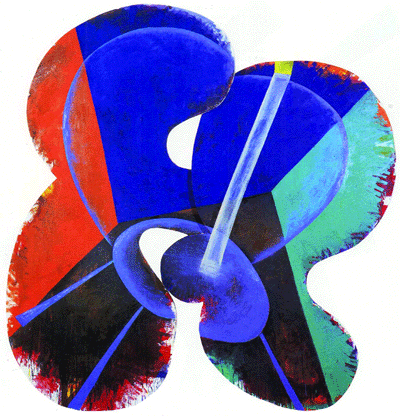Elizabeth Murray retrospective directs attention to a great living master
The Museum of Modern Art has seized a great opportunity to show off with a retrospective by one of our greatest living painting masters, Elizabeth Murray. Born in Chicago in 1940, Murray lived in northern California before coming to New York to begin her slow and rock-solid rise to the top. Reacting to the boy’s club of minimalism, she embraced her own life for subject matter, the history of painters for clues to push against, her intuition to fuel invention, and a love of painting to turn art on its side, upside down, and inside out.
Constantly wrestling with the demons and definitions of painting, Murray denied its desire to become sculpture and resisted its gravitational pull to come off the wall. By her ability to keep many balls in the air at once, in her many obtuse references, and through the examination of the public issues de jour, she is truly contemporary, and is one of the most important artists our world has produced. She took the long road and stuck to her guns, whether the spotlight was on her or not, but she has emerged the winner over the artists who played the game a little bit louder and used the power of spectacle and the media to create their illusions of importance. Aren’t they all film directors or Photoshop junkies now?
From the her early image paintings and minimalist works to the full-blown, unbridled stacked, shattered, and curve-shaped canvases painted in bright color that made her a star, we see her making connections and forcing solutions, while the brush is in her hand, and opposing the production demands of popular conceptual academia that has swallowed art and held us hostage for the last 20 years.
“Beer Glass at Noon” (1971), a small brown Cubist-like painting of a stemmed glass of beer from Murray’s earliest days, functions as a marker in the show between her first peak of productivity with breakthrough paintings such as “Deeper-Than-D” (1983) and “More than You Know,” (1983) and a latter period in which the work gets dark and twisted as in pieces such as “Wonderful World” (1988), “True Air” (1988), and “Trembling Foot” (1988). This later period reminds me of the period when Pollock had already become a brand name superstar and the art world wanted him to become a machine spitting out “Pollocks,” and he instead chose to dive back into the inertia of painting to go deeper in search for meaning, refusing to play the game. Resisting the fickle spotlight, it seems Murray made a similar artist decision and let this darker period, warts and all, emerge, braving the unknown and fighting for her life. Unfortunately Pollock died in the middle of this struggle, but Murray, just like De Kooning, somehow passed through the eye of the needle, bearing the fruits of a gladiator’s successful battle.
In the next room, there is a diary in which Murray wrote about a dream. In it she is on the phone to a well-known, power critic who had once championed her work, but since turned her back on her in search of “newer ideas.” When she refuses her dinner invitation in a very chilly manner, Murray says to her self, “The hell with them, at least I tried.” Many artists don’t make it through the part of their career when they are left alone and their ideas have been replaced with a new fashion or a new art theory. Artists always want to be current, but so often their work then becomes all about seeking approval; it is mannerist of itself. It’s in response to this challenge that her real breakthrough occurs. Murray said, “Fuck it,” and the rest of the show rises like a phoenix from the ashes of that defiance.
The last gallery is filled with her most recent work; she just finished one week before, and it’s a revelation. It feels that she has made peace with her paintings. Her vocabulary, methods, and issues have been won and her surrender and realization that there is nothing to prove to anyone has allowed her to produce the most inspired works of her career. These paintings begin to function like Poussin’s “Rape of the Sabine Women;” everything is happening all at once and all hell has broken loose. She demonstrates that in our hypermodern world our relationship to people, places, and things change from minute to minute, and with the increased pace and complexity of our communication, our intercourse becomes like a big cartoon thought bubble. Each cluster becomes its own reality. And in the end, “reality” is just a big “idea.”
gaycitynews.com



































